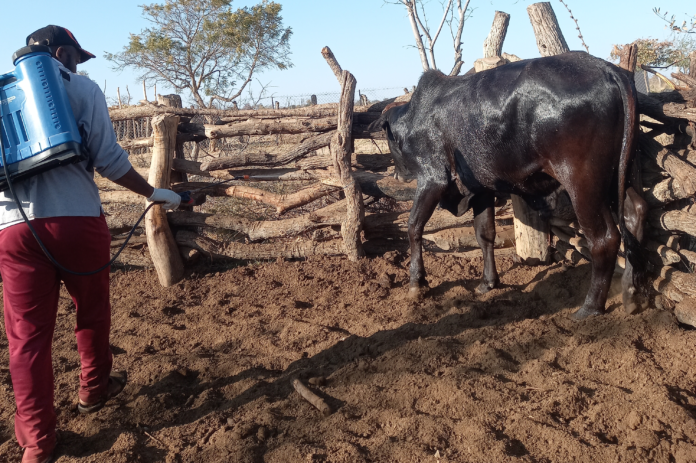Safer and Greener Disinfection
Rigorous tests carried out by the World Health Organisation (WHO) have revealed that most traditional surface disinfectants for livestock contain toxins which are classified as a health hazard and pollutants. This necessitates cattle farmers to adopt safer and greener alternative disinfectants to demonstrate their commitment to sustainable business practices (Environment, Social and Governance).
By Nick Barnes
Foot and mouth disease (FMD) has cost cattle farmers in Southern Africa – South Africa and Botswana in particular – easily over two billion of rands in revenue loss – as importing countries of animals and animal products only buy from FMD-free countries. Governments – the departments of agriculture and relevant authorities in affected countries in this context – may do their utmost by committing resources towards enforcement of policies of good veterinary governance to prevent and control the spread of the virus. Nevertheless, all things considered, the buck stops with farmers themselves who have to adopt appropriate means to protect their herd. And one of the elements in the first line of defence is the use of surface livestock disinfectants, which are used in regular cleaning and disinfection of livestock pens, buildings, vehicles and equipment.
Read: Farmers Review Africa 2021 edition
Cattle farmers have to make judicious decisions on the choices concerning the relevance and quality of disinfectants they use. In particular, Current legislation obligates livestock farmers – indeed the agricultural sector – to only use suitable products whose efficacy in the containment of viruses, bacteria and fungi has been verified.
Growing interest in alternative disinfectants
Interestingly, there has been growing interest in what are deemed safe and environmentally-friendly disinfectants as the agricultural sector embraces sustainability (Environment Social and Governance) in its business model. Though, it would be an exaggeration for anyone to claim that there is a revolution in surface disinfectant markets, where traditional products are being phased out of the market, and non-toxic and biodegradable alternatives are replacing them. It is entirely upon the livestock farmer to elect to use products which are classified as safe and eco-friendly as part of their commitment to sound business ethics (ESG).
Read also: Fighting Foot-and-mouth disease, the modern way.
Surface disinfectants based on hydrogen peroxide are considered as an alternative to traditional surface disinfectants like hypochlorite, the most preferred chlorine disinfectant available in both solid and liquid forms. Rigorous tests carried out by the World Health Organisation (WHO) have revealed that most traditional surface disinfectants contain toxins which are classified as a health hazard and pollutants. In one report released in May 2020, the WHO warned: “Spraying or fogging of certain chemicals, such as formaldehyde, chlorine-based agents or quaternary ammonium compounds, is not recommended due to adverse health effects on workers in facilities where these methods have been utilised.”
Judicious procurement decisions
As expected, in response to this growing niche demand, manufacturers are producing biodegradable disinfectants based on hydrogen peroxide (H2O2) solution. Unfortunately, the malpractice of greenwashing, rampant in other veterinary products, has not spared the non-toxic and biodegradable detergents niche market, posing a challenge for farmers to tell the genuine from the counterfeit. It is not uncommon, in the core business of pushing sales to increase revenue, for manufacturers and major suppliers of non-toxic and biodegradable disinfectants to claim that their product is the ‘leading natural and toxic free cleaning and decontamination natural alternative’ widely used to control microorganisms.
Accordingly, it is entirely upon the cattle farmers to exercise prudence and make judicious decisions when choosing products in a market awash with hundreds of product brands. Any doubts cattle farmers may have about the veracity of claims by suppliers made can be settled by referring to certification by any of the credible entities. Prudence would be the operative word at all times.
All the more, as regards proper usage, it is the farmer’s responsibility. Respective regulatory bodies make it mandatory for all label use directions and safety precautions to be followed. In the U.S., for instance, the Environmental Protection Agency (EPA) regulates disinfectants (referred to as antimicrobial pesticides) under the Federal Insecticide, Fungicide, and Rodenticide Act (FIFRA). In South Africa, this falls under Section 13 (1) of the National Regulator for Compulsory Specifications Act (Act 5 of 2008) – Compulsory Specification for Chemical Disinfectants (VC 8054).
The future of biodegradable products
Generally, notwithstanding COVID-19, there are huge prospects that the African livestock surface disinfectant market size is set for exponential growth in the coming years. This is mainly down to increasing awareness amongst farmers concerning animal diseases – a phenomenon which is expected to occasion growing demand for stockyard disinfectants. There are indications that the African livestock surface disinfectant market size is set for a growth trajectory. Valued at USD 65.0 million in 2018, a market review predicts that it is likely to expand at a CAGR of 6.3% by 2025.1
Africa Livestock Surface Disinfectant Market Size, Share & Trends Analysis Report By Chemical, By Form, By Livestock (Cattle, Pig), By Country, And Segment Forecasts, 2019 – 2025 1
Read more : Farmers Review Africa Sept/Oct 2021 edition









[…] parts. This contrasts with simple non-formulated disinfectants, which require very high levels of biocidal ingredients that are more likely to lead to toxic and environmentally hazardous results. These raw disinfectants are also not as effective at containing disease as their formulated […]
Comments are closed.